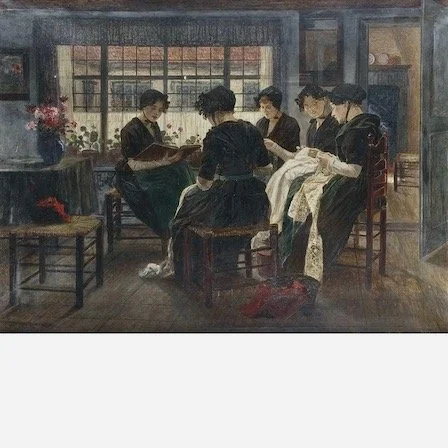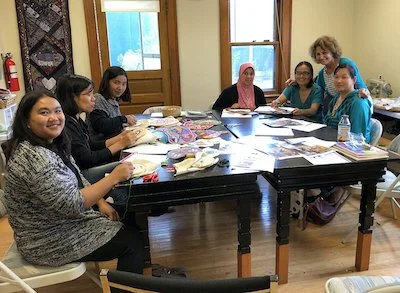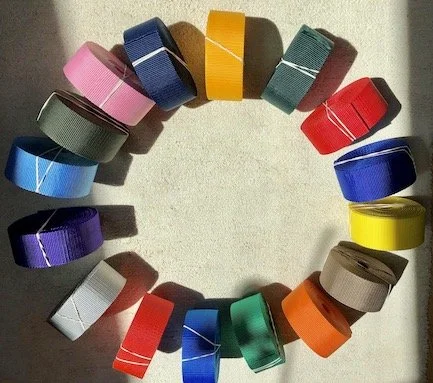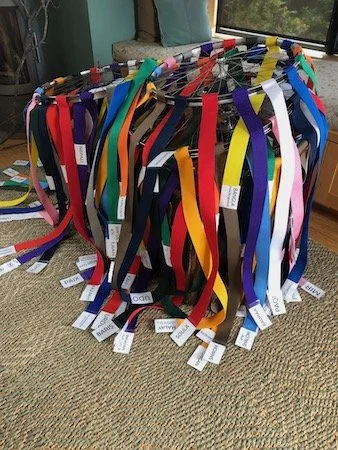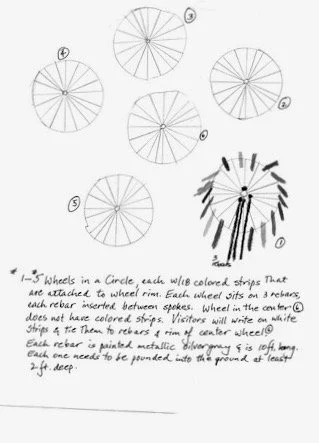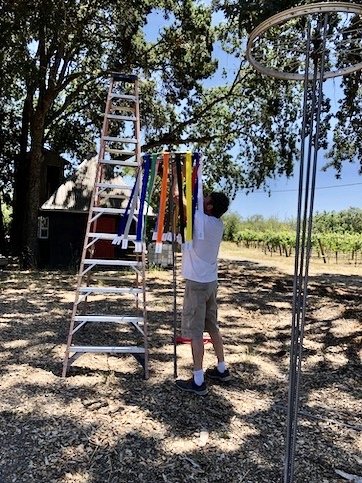Wheels for Peace—public art
Who can predict the future? Do we ever know how things will turn out? All we can do is remain open and flexible, adapting to the changes that come, changes that, for the most part, are clearly not under our control. Doesn’t this happen to everyone involved in creative ventures? Sometimes an idea for an art project grabs a hold of us. We can see it clearly in our mind and strive to make it physically real. Yet, the stars don’t align and the idea doesn’t come to fruition, at least not when and how we intended. We might feel a sense of loss for not accomplishing it and notice doubts creeping in about the project’s viability. We wonder whether to simply let go and move on to something else.
That’s what happened to me several years ago. I wanted very much to initiate a community public art project by gathering a diverse group of people to sit around a table and stitch together. Nothing new about that, for women have been doing it for millennia.
Sewing Circle, by Walter Firle (1859 – 1929), Polish-German painter. Source: mutualart.com/
Except that, specifically, I envisioned individuals of different cultural backgrounds embroidering onto cloth the word or expression for peace in their native language. Given the pervasive mood of negativity and fear fostered by political rhetoric, divisive mongering, and “other” bashing, I sought to create an experience that could counterbalance the growing tension and conflict around the world. My hope was that people would come to see each other not as aliens, but as neighbors whose ethnic forebears also desired peace, as evidenced by its inclusion in their vocabulary. I imagined many embroidery hoops holding stitched cloths hanging at different levels from a ceiling. Visitors to the installation would walk through a “peace forest,” encountering an atmosphere in which they could feel at ease rather than afraid or assaulted. They could recognize the word from their ancestral language and feel included.
Source: www.stitchbuffalo.org/
Alas, it was not to be. COVID and its accompanying isolation were soon upon us, making a community project impossible. Disappointed, I let it go. Little did I know that my original idea would transmogrify into something entirely unexpected. Here’s what happened.
In the first quarter of 2022, I heard about a public art program sponsored by Creative Sonoma. Artists selected to participate in Art Surround would have the opportunity to add public art to different venues in various towns and cities of Sonoma County in northern California. I decided to apply, for it seemed a great opportunity to stretch myself. I was delighted to be awarded a grant. We went through a training weekend and then were paired up with “art advocates,” generally non-profit organizations. Because I speak Spanish and lived in South America, I wanted to collaborate with a Latino community. Unfortunately, Plan A came to naught. With the support of administrators at Creative Sonoma, I segued to Plan B. I wound up working with Bryce Jones at the outdoor sculpture garden in Geyserville.
South end of sculpture garden, Geyserville, California.
So what do you do when the various ways you’ve been creating art just don’t fit the place you’re assigned to? I am not accustomed to working large or in metal, but suddenly I was faced with an environment in which many sculptures are HUGE. How could I possibly scale up, not to mention adapt both textiles and handmade paper to an al fresco setting? How would wind, sunshine, and maybe rain affect my materials? I remember walking through the sculpture garden, considering whether I could hang textile objects from tree branches. Or could I use textiles to weave an abstract design through a chain link fence at the south boundary? In the end, none of the ideas I came up with struck the right chord. It was definitely time to think outside the box I had been operating in. And that’s how Wheels for Peace grew into a sizeable outdoor installation.
Reflecting back on the process I went through, I don’t know how I would have managed the challenge without the encouragement and advice of dear artist friends. Step by step, I examined different materials until I figured out which would suit my intention for them to be colorful, durable, mobile, and able to incorporate words for peace in different languages. I tested widths, lengths and heights, attachment modes, color combinations, stitching, and much more until I got to where I needed to go. There was plenty of frustration along the way, but the learning curve and artistic support were so valuable.
Setting up a model to determine rebar length and wheel height.
Deciding on order of colored ribbons.
Checking different ribbon lengths.
Sample ribbons pinned to rim to test hanging from wheel.
Each wheel has 18 ribbons and laminated labels, everything attached by machine-stitching.
Crude sketch in preparation for installation.
Finally, it was time to install the wheels in the sculpture garden, except there was one delay after another in the scheduling of a public event. So the wheels sat in my studio, like jelly fish collapsed on a beach. Then, in the midst of repeated postponements in Geyserville, Trini and Lisa Amador, gracious owners of Gracianna Winery in Healdsburg, asked whether I would set up the wheels in their vineyard. I got permission from Creative Sonoma to do so. I went to the winery, chose a spot under some big oaks, and on July 9 met with Tom and Jaime, who work on various projects at the winery. They made the installation possible, for it turned out to require the kind of strength I no longer have, not to mention the height I never had! Fortunately, it was a beautiful day and there were no hitches. I couldn’t have asked for a better team or weather.
Tom adjusting wheel after pounding 3 rebars into the hard ground to hold it.
All done.
A statement about Wheels for Peace is attached to the trunk of one of the oaks. I explain that it is a natural outgrowth of my ongoing cross-cultural experiences. Born in Italy to parents from Poland, and immigrating to the U.S. as a youngster, I have found myself moving all over the world. Living, working, and traveling in so many places have taught me that, despite differences in language, customs, food, environment, and the arts, there are aspects which unify rather than separate us. One which is vital to global well-being is that each culture has a word, expression, or symbol signifying “peace.” And peace is far more than an intellectual concept. It is a felt experience accessible through our body’s senses and available to those who choose it over violence. Through the simplicity of form and color, anyone walking inside and around the circle of wheels has an opportunity to enjoy a moment of pleasurable calm. And, for those who are so inclined, this is also a chance to consider the fact that, across the planet, diverse spiritual traditions—not just our own—incorporate prayers and other practices for peace.
Walking around and in Wheels for Peace. (Photo by Fiona Warner)
Arranged in a large circle, the wheels themselves are circles. As a universal symbol, the circle represents ideals of wholeness, perfection, totality, the infinite, timelessness, and cyclic movement. The peace icon that is internationally recognized is also a circle. And right in the middle of the five beribboned wheels is a wheel waiting to be adorned by visitors who attach their own aspirations for peace with the Sharpies and white ribbons provided on a picnic table under the oaks. I hope you have a chance to add your wishes in a beautiful setting in the countryside. Like Tibetan prayer flags sending good thoughts out to the world, may all the messages people add to the center wheel do the same.
Richard Lang writing a personal message for peace. (Photo by Judith Selby-Lang).
Beverley Chisholm adding a wish of friendship to center wheel. (Photo by Fiona Warner)
All we are saying is give peace a chance
All we are saying is give peace a chance
—John Lennon and the Plastic Ono Band
The installation will remain at Gracianna Winery through Labor Day. It will move to the sculpture garden in Geyserville later in September. Afterwards, it will be installed in a redwood grove at Gualala Arts Center. I am deeply grateful to Creative Sonoma and everyone who has supported me in creating this public art project.
